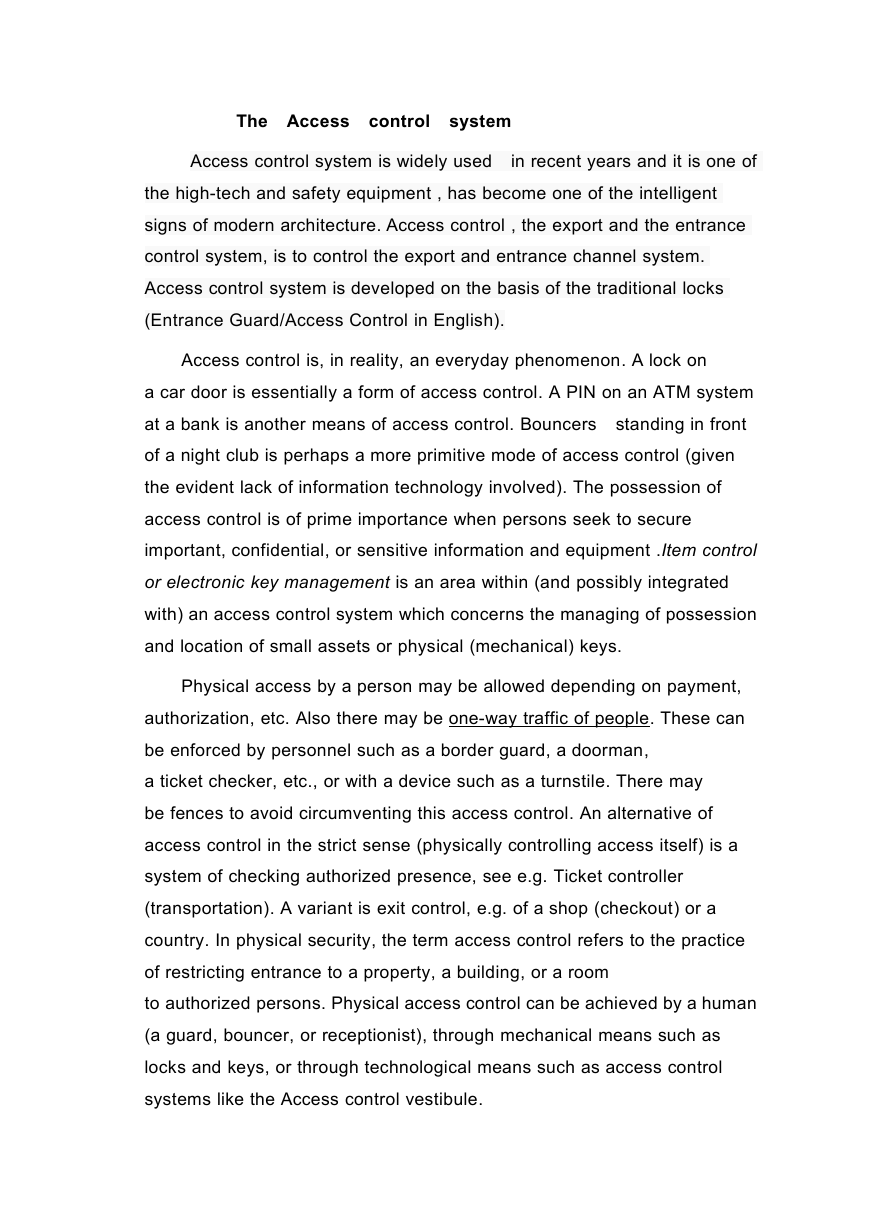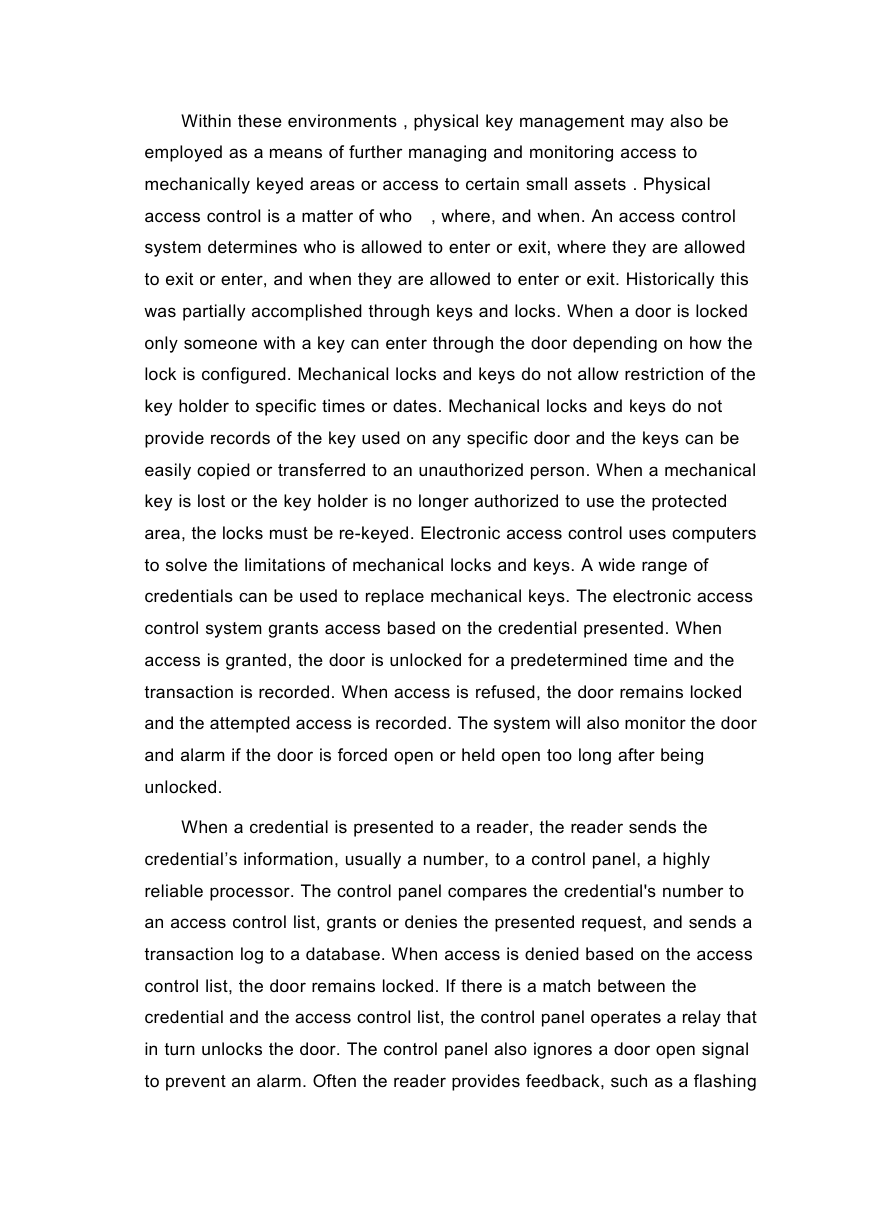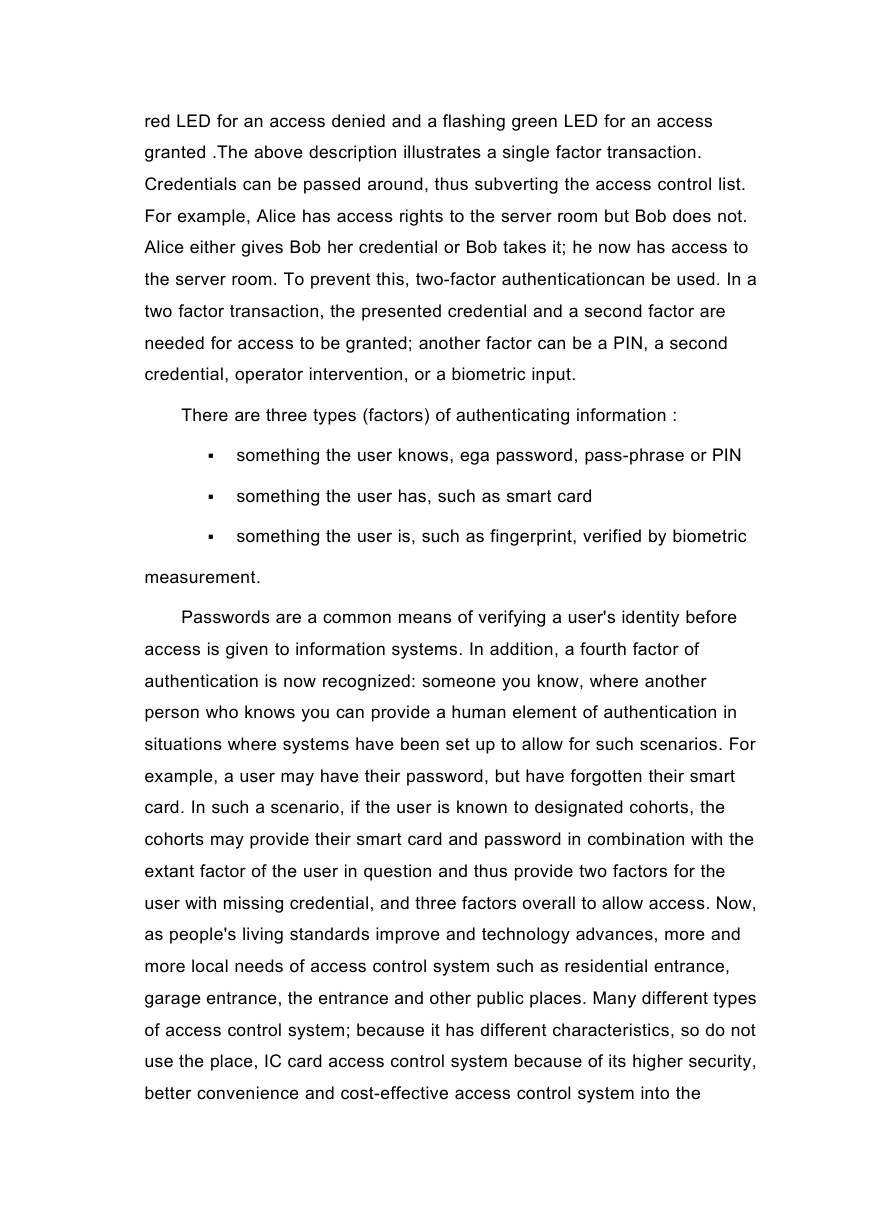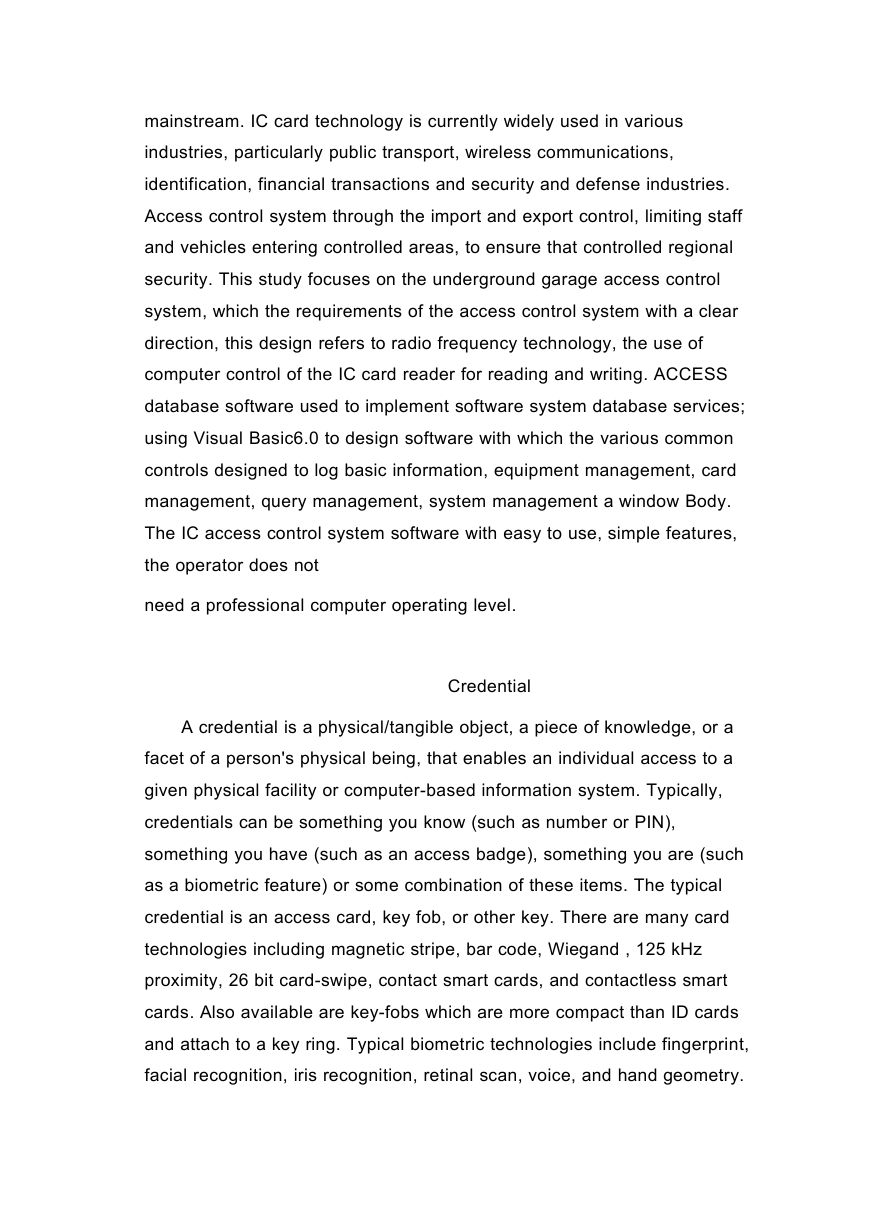沈阳工业大学
本科生毕业设计(论文)外文翻译
毕业设计题目:
楼宇门禁监管系统软件设计
学
院: 信息科学与工程学院
专业班级:
通信工程 0902
学生姓名: 格根哈斯 090404049
指导教师:
赵柏山
2013 年 03 月 18 日
�
The Access control system
Access control system is widely used in recent years and it is one of
the high-tech and safety equipment , has become one of the intelligent
signs of modern architecture. Access control , the export and the entrance
control system, is to control the export and entrance channel system.
Access control system is developed on the basis of the traditional locks
(Entrance Guard/Access Control in English).
Access control is, in reality, an everyday phenomenon. A lock on
a car door is essentially a form of access control. A PIN on an ATM system
at a bank is another means of access control. Bouncers
standing in front
of a night club is perhaps a more primitive mode of access control (given
the evident lack of information technology involved). The possession of
access control is of prime importance when persons seek to secure
important, confidential, or sensitive information and equipment .Item control
or electronic key management is an area within (and possibly integrated
with) an access control system which concerns the managing of possession
and location of small assets or physical (mechanical) keys.
Physical access by a person may be allowed depending on payment,
authorization, etc. Also there may be one-way traffic of people. These can
be enforced by personnel such as a border guard, a doorman,
a ticket checker, etc., or with a device such as a turnstile. There may
be fences to avoid circumventing this access control. An alternative of
access control in the strict sense (physically controlling access itself) is a
system of checking authorized presence, see e.g. Ticket controller
(transportation). A variant is exit control, e.g. of a shop (checkout) or a
country. In physical security, the term access control refers to the practice
of restricting entrance to a property, a building, or a room
to authorized persons. Physical access control can be achieved by a human
(a guard, bouncer, or receptionist), through mechanical means such as
locks and keys, or through technological means such as access control
systems like the Access control vestibule.
�
Within these environments , physical key management may also be
employed as a means of further managing and monitoring access to
mechanically keyed areas or access to certain small assets . Physical
access control is a matter of who , where, and when. An access control
system determines who is allowed to enter or exit, where they are allowed
to exit or enter, and when they are allowed to enter or exit. Historically this
was partially accomplished through keys and locks. When a door is locked
only someone with a key can enter through the door depending on how the
lock is configured. Mechanical locks and keys do not allow restriction of the
key holder to specific times or dates. Mechanical locks and keys do not
provide records of the key used on any specific door and the keys can be
easily copied or transferred to an unauthorized person. When a mechanical
key is lost or the key holder is no longer authorized to use the protected
area, the locks must be re-keyed. Electronic access control uses computers
to solve the limitations of mechanical locks and keys. A wide range of
credentials can be used to replace mechanical keys. The electronic access
control system grants access based on the credential presented. When
access is granted, the door is unlocked for a predetermined time and the
transaction is recorded. When access is refused, the door remains locked
and the attempted access is recorded. The system will also monitor the door
and alarm if the door is forced open or held open too long after being
unlocked.
When a credential is presented to a reader, the reader sends the
credential’s information, usually a number, to a control panel, a highly
reliable processor. The control panel compares the credential's number to
an access control list, grants or denies the presented request, and sends a
transaction log to a database. When access is denied based on the access
control list, the door remains locked. If there is a match between the
credential and the access control list, the control panel operates a relay that
in turn unlocks the door. The control panel also ignores a door open signal
to prevent an alarm. Often the reader provides feedback, such as a flashing
�
red LED for an access denied and a flashing green LED for an access
granted .The above description illustrates a single factor transaction.
Credentials can be passed around, thus subverting the access control list.
For example, Alice has access rights to the server room but Bob does not.
Alice either gives Bob her credential or Bob takes it; he now has access to
the server room. To prevent this, two-factor authenticationcan be used. In a
two factor transaction, the presented credential and a second factor are
needed for access to be granted; another factor can be a PIN, a second
credential, operator intervention, or a biometric input.
There are three types (factors) of authenticating information :
something the user knows, ega password, pass-phrase or PIN
something the user has, such as smart card
something the user is, such as fingerprint, verified by biometric
measurement.
Passwords are a common means of verifying a user's identity before
access is given to information systems. In addition, a fourth factor of
authentication is now recognized: someone you know, where another
person who knows you can provide a human element of authentication in
situations where systems have been set up to allow for such scenarios. For
example, a user may have their password, but have forgotten their smart
card. In such a scenario, if the user is known to designated cohorts, the
cohorts may provide their smart card and password in combination with the
extant factor of the user in question and thus provide two factors for the
user with missing credential, and three factors overall to allow access. Now,
as people's living standards improve and technology advances, more and
more local needs of access control system such as residential entrance,
garage entrance, the entrance and other public places. Many different types
of access control system; because it has different characteristics, so do not
use the place, IC card access control system because of its higher security,
better convenience and cost-effective access control system into the
�
mainstream. IC card technology is currently widely used in various
industries, particularly public transport, wireless communications,
identification, financial transactions and security and defense industries.
Access control system through the import and export control, limiting staff
and vehicles entering controlled areas, to ensure that controlled regional
security. This study focuses on the underground garage access control
system, which the requirements of the access control system with a clear
direction, this design refers to radio frequency technology, the use of
computer control of the IC card reader for reading and writing. ACCESS
database software used to implement software system database services;
using Visual Basic6.0 to design software with which the various common
controls designed to log basic information, equipment management, card
management, query management, system management a window Body.
The IC access control system software with easy to use, simple features,
the operator does not
need a professional computer operating level.
Credential
A credential is a physical/tangible object, a piece of knowledge, or a
facet of a person's physical being, that enables an individual access to a
given physical facility or computer-based information system. Typically,
credentials can be something you know (such as number or PIN),
something you have (such as an access badge), something you are (such
as a biometric feature) or some combination of these items. The typical
credential is an access card, key fob, or other key. There are many card
technologies including magnetic stripe, bar code, Wiegand , 125 kHz
proximity, 26 bit card-swipe, contact smart cards, and contactless smart
cards. Also available are key-fobs which are more compact than ID cards
and attach to a key ring. Typical biometric technologies include fingerprint,
facial recognition, iris recognition, retinal scan, voice, and hand geometry.
�
Access control system components
An access control point, which can be a door, turnstile, parking gate,
elevator, or other physical barrier where granting access can be
electronically controlled. Typically the access point is a door. An electronic
access control door can contain several elements. At its most basic there is
a stand-alone electric lock. The lock is unlocked by an operator with a
switch. To automate this, operator intervention is replaced by a reader. The
reader could be a keypad where a code is entered, it could be a card reader,
or it could be a biometric reader. Readers do not usually make an access
decision but send a card number to an access control panel that verifies the
number against an access list. To monitor the door position a magnetic door
switch is used. In concept the door switch is not unlike those on
refrigerators or car doors. Generally only entry is controlled and exit is
uncontrolled. In cases where exit is also controlled a second reader is used
on the opposite side of the door. In cases where exit is not controlled, free
exit, a device called a request-to-exit (RTE) is used. Request-to-exit
devices can be a pushbutton or a motion detector. When the button is
pushed or the motion detector detects motion at the door, the door alarm is
temporarily ignored while the door is opened. Exiting a door without having
to electrically unlock the door is called mechanical free egress. This is an
important safety feature. In cases where the lock must be electrically
unlocked on exit, the request-to-exit device also unlocks the door.
Access control topology
Access control decisions are made by comparing the credential to an
access control list. This lookup can be done by a host or server, by an
access control panel, or by a reader. The development of access control
systems has seen a steady push of the lookup out from a central host to the
edge of the system, or the reader. The predominate topology circa 2009 is
hub and spoke with a control panel as the hub and the readers as the
spokes. The lookup and control functions are by the control panel. The
spokes communicate through a serial connection; usually RS485. Some
�
manufactures are pushing the decision making to the edge by placing a
controller at the door. The controllers are IP enabled and connect to a host
and database using standard networks.
Types of readers
Access control readers may be classified by functions they are able to
perform:
Basic (non-intelligent) readers: simply read card number or PIN
and forward
it to a control panel. In case of biometric identification, such readers output
ID number of a user. Typically Wiegand protocol is used for transmitting
data to the control panel, but other options such as RS-232, RS-485 and
Clock/Data are not uncommon. This is the most popular type of access
control readers. Examples of such readers are RF Tiny by RFLOGICS, Prox
Point by HID, and P300 by Far pointe Data.
Semi-intelligent readers: have all inputs and outputs necessary
to control door hardware (lock, door contact, exit button), but do not
make any access decisions. When a user presents a card or enters PIN, the
reader sends information to the main controller and waits for its response. If
the connection to the main controller is interrupted, such readers stop
working or function in a degraded mode. Usually semi-intelligent readers
are connected to a control panel via an RS-485 bus. Examples of such
readers are InfoProx Lite IPL200 by CEM Systems and AP-510 by Apollo.
Intelligent readers: have all inputs and outputs necessary to
control door hardware, they also have memory and processing power
necessary to make access decisions independently. Same as
semi-intelligent readers they are connected to a control panel via an RS-485
bus. The control panel sends configuration updates and retrieves events
from the readers. Examples of such readers could be InfoProx IPO200 by
CEM Systems and AP-500 by Apollo. There is also a new generation of
�
intelligent readers referred to as "IP readers". Systems with IP readers
usually do not have traditional control panels and readers communicate
directly to PC that acts as a host. Examples of such readers are PowerNet
IP Reader by Isonas Security Systems, ID08 by Solus has the built in
webservice to make it user friendly, Edge ER40 reader by HID Global,
LogLock and UNiLOCK by ASPiSYS Ltd, and BioEntry Plus reader by
Suprema Inc .
Some readers may have additional features such as LCD and function
buttons for data collection purposes (i.e. clock-in/clock-out events for
attendance reports), camera/speaker/microphone for intercom, and smart
card read/write support.
Access control readers may also be classified by the type
of identification technology.
Attribute-based access control
In attribute-based access control (ABAC), access is granted not based
on the rights of the subject associated with a user after authentication, but
based on attributes of the user. The user has to prove so called claims
about his attributes to the access control engine. An attribute-based access
control policy specifies which claims need to be satisfied in order to grant
access to an object. For instance the claim could be "older than 18" . Any
user that can prove this claim is granted access. Users can be anonymous
as authentication and identification are not strictly required. One does
however require means for proving claims anonymously. This can for
instance be achieved usinganonymous credentials or XACML (extensible
access control markup language).
�
















 2023年江西萍乡中考道德与法治真题及答案.doc
2023年江西萍乡中考道德与法治真题及答案.doc 2012年重庆南川中考生物真题及答案.doc
2012年重庆南川中考生物真题及答案.doc 2013年江西师范大学地理学综合及文艺理论基础考研真题.doc
2013年江西师范大学地理学综合及文艺理论基础考研真题.doc 2020年四川甘孜小升初语文真题及答案I卷.doc
2020年四川甘孜小升初语文真题及答案I卷.doc 2020年注册岩土工程师专业基础考试真题及答案.doc
2020年注册岩土工程师专业基础考试真题及答案.doc 2023-2024学年福建省厦门市九年级上学期数学月考试题及答案.doc
2023-2024学年福建省厦门市九年级上学期数学月考试题及答案.doc 2021-2022学年辽宁省沈阳市大东区九年级上学期语文期末试题及答案.doc
2021-2022学年辽宁省沈阳市大东区九年级上学期语文期末试题及答案.doc 2022-2023学年北京东城区初三第一学期物理期末试卷及答案.doc
2022-2023学年北京东城区初三第一学期物理期末试卷及答案.doc 2018上半年江西教师资格初中地理学科知识与教学能力真题及答案.doc
2018上半年江西教师资格初中地理学科知识与教学能力真题及答案.doc 2012年河北国家公务员申论考试真题及答案-省级.doc
2012年河北国家公务员申论考试真题及答案-省级.doc 2020-2021学年江苏省扬州市江都区邵樊片九年级上学期数学第一次质量检测试题及答案.doc
2020-2021学年江苏省扬州市江都区邵樊片九年级上学期数学第一次质量检测试题及答案.doc 2022下半年黑龙江教师资格证中学综合素质真题及答案.doc
2022下半年黑龙江教师资格证中学综合素质真题及答案.doc